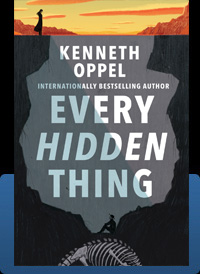 |
|
 |
“BEHIND THE STORY”
Every Hidden Thing by Kenneth Oppel
Dinosaurs are so commonplace now, in museums, on the silver screen, that we almost take their magnificence for granted. But what, I wondered, would it have been like to be that first person to dig up a massive dinosaur bone? Imagine the excitement, the torrent of questions: “What on earth have I discovered?”
My initial research on the first documented dinosaur find (Richard Owen, 1842, the Iguanadon, in London of all places!) quickly brought me to the pioneering American paleontologists Edward Drinkwater Cope and Charles Othniel Marsh. Their rivalry in the 1870s was known as the Bone Wars: between them, they named and claimed over a hundred dinosaur species, while also energetically trying to destroy each other’s careers. These two larger-than-life characters were the inspiration for the paleontologist fathers in Every Hidden Thing. And if you’ve got two fathers who hate each other, doesn’t it make sense their respective teenaged children will fall in love?
I had a lot to learn for this book. I tried to bone up on anatomy so I could recognize joints and femurs and humerii. I spent a lot of time at the museum, measuring T-Rex's and centrosaurs and pterosaurs. But I also wanted to know what it was like to swelter in the sun in search of fossils, so I managed to get myself invited on a short field expedition in Dinosaur Provincial Park in Alberta.
This was my Indiana Jones moment. I bought hiking boots, and a hat. I wanted a bullwhip but MEC wouldn’t sell me one. The badlands terrain was a like an ancient hidden world, literally sunken below prairie level: buttes and ravines and coulees and rocks of astonishingly different textures and colours. And mosquitoes, lots and lots of them. During my stay I got a crash course in prospecting, quarrying out fossils, and preparing them back in the lab. And I also got to ask my patient paleontologist hosts about everything from the history of paleontology, to how to identify bone -- something which I was useless at. Prospecting, I felt like a pesky cartoon character, calling out every few seconds, “Don, hey, Don, is this bone?” A glance was all it took for him. “Nope. That’s glacial erratic limestone.” “Hey, Don, how about this?” “That’s petrified wood.” “Hey, Don, I think I’ve got something big here!” “That’s a rabbit skull. It’ll be a fossil in 65 million years.”
There were a ton of other things I needed to learn about. The birth of American paleontology intersected with aggressive American westward expansion, and increasing tension with the American Indians prior to the Great Sioux War of 1876. I took pains to research the Lakota Indians, whose homelands and way of life were being stolen and eradicated, and I was fortunate to have my manuscript reviewed in advance by a Lakota reader to make sure my depictions of indigenous peoples were accurate and respectful.
During my brief time in the Badlands, one of the amazing things I learned about paleontology was that the work methods haven’t changed much in 140 years. You walk, you look, you dig, and when you find bone, you shovel. It can be tedious and sweaty, but exhilarating. After a day of prospecting, standing on a lookout, I asked my host: “If you had a machine that could see inside all these hills, would you do it?” He shook his head. “What would be the fun of that?”
|
|

Click the images for more information
|
|